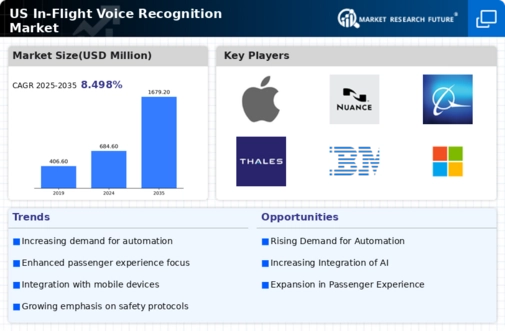Increased Focus on Customer Experience
The in flight-voice-recognition market is increasingly driven by a heightened focus on customer experience. Airlines are recognizing that enhancing passenger interactions can lead to improved satisfaction and loyalty. Voice recognition technology allows for more intuitive and efficient communication, enabling passengers to make requests or receive information without the need for physical interaction. This is particularly relevant in the context of evolving passenger expectations for convenience and efficiency. As of 2025, it is projected that airlines investing in voice recognition systems will see a 20% increase in customer satisfaction ratings. By prioritizing customer experience through innovative technologies, airlines are positioning themselves favorably within the competitive landscape of the in flight-voice-recognition market.
Growing Demand for Personalized Services
The in flight-voice-recognition market is significantly influenced by the growing demand for personalized services among travelers. Passengers increasingly expect tailored experiences during their flights, prompting airlines to adopt advanced voice recognition systems that can cater to individual preferences. By utilizing voice recognition technology, airlines can offer customized meal options, entertainment selections, and other services based on passenger profiles. This shift towards personalization is expected to drive market growth, as airlines recognize the potential to enhance customer loyalty and satisfaction. In 2025, it is estimated that 60% of airlines will implement voice recognition systems to provide personalized services, reflecting a broader trend in the travel industry. The ability to engage passengers through voice commands not only improves the overall travel experience but also positions airlines competitively within the in flight-voice-recognition market.
Expansion of In-Flight Entertainment Systems
The in flight-voice-recognition market is poised for growth due to the expansion of in-flight entertainment systems that incorporate voice recognition capabilities. As airlines enhance their entertainment offerings, integrating voice recognition allows passengers to interact with systems more naturally and intuitively. This trend is particularly appealing to tech-savvy travelers who prefer voice commands over traditional interfaces. By 2025, it is estimated that 75% of airlines will offer voice-activated entertainment systems, reflecting a shift towards more engaging and user-friendly experiences. The integration of voice recognition into in-flight entertainment not only enriches the passenger experience but also aligns with broader technological trends in the aviation industry, thereby driving growth in the in flight-voice-recognition market.
Regulatory Support for Innovative Technologies
The in flight-voice-recognition market benefits from increasing regulatory support for innovative technologies in the aviation sector. Regulatory bodies are recognizing the potential of voice recognition systems to enhance safety and operational efficiency. As regulations evolve, airlines are encouraged to adopt these technologies, which can streamline communication and reduce misunderstandings between crew and passengers. In 2025, it is anticipated that new guidelines will be established to facilitate the integration of voice recognition systems into airline operations. This regulatory support is likely to foster innovation and investment in the in flight-voice-recognition market, as airlines seek to comply with safety standards while improving service delivery. The alignment of regulatory frameworks with technological advancements may create a conducive environment for the growth of voice recognition solutions in the aviation industry.
Technological Advancements in Voice Recognition
The in flight-voice-recognition market is experiencing rapid technological advancements that enhance the accuracy and efficiency of voice recognition systems. Innovations in artificial intelligence (AI) and machine learning (ML) are driving improvements in natural language processing, enabling systems to better understand and respond to passenger requests. As of 2025, the market is projected to grow at a CAGR of 15%, reflecting the increasing demand for seamless communication between passengers and airline staff. Airlines are investing in sophisticated voice recognition technologies to streamline operations and improve customer service, which is crucial in a competitive landscape. Enhanced voice recognition capabilities not only improve user experience but also reduce operational costs by minimizing the need for manual intervention. This trend indicates a strong future for the in flight-voice-recognition market, as airlines seek to leverage technology to enhance passenger satisfaction.




















Leave a Comment